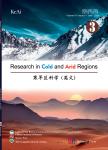Water sources of plants and groundwater in typical ecosystems in the lower reaches of the Heihe River Basin
Water sources of plants and groundwater in typical ecosystems in the lower reaches of the Heihe River Basin作者机构:Key Laboratory of Ecohydrology and Integrated River Basin Science of CAS Cold and Arid Regions Environmental and Engineering Research Institute Chinese Academy of Sciences University of Chinese Academy of Sciences Key Laboratory of Heihe Ecohydrology and Basin Science of Gansu Province
出 版 物:《Research in Cold and Arid Regions》 (寒旱区科学(英文版))
年 卷 期:2014年第6卷第3期
页 面:226-235页
核心收录:
学科分类:081803[工学-地质工程] 07[理学] 08[工学] 0818[工学-地质资源与地质工程] 0713[理学-生态学]
基 金:supported by the National Natural Science Foundation of China (Grant Nos. 91325102, 91025016 and 91125025) the National Science & Technology Support Project (No. 2011BAC07B05)
主 题:stable hydrogen and oxygen isotope composition (δD and δa80) extremely arid regions lower reaches of theHeihe River Basin plant water sources
摘 要:Stable oxygen and hydrogen isotopic compositions (δ18O and δD) of soil water and shallow groundwater of a riparian forest, an artificial shrub forest, and Gobi of the lower reaches of the Heihe River Basin are used to study the recharge water sources of those ecosystems. IsoSource software is used to determine the δ180 values for root water of Populous euphratica and Tamarix ramosissima in the riparian forest ecosystem, Haloxylon ammodendron in the artificial shrub forest, and Reaumuria soongorica in the Gobi, as well as for local soil water and groundwater, and precipitation in the upper reaches of the Heihe River Basin. Our results showed that soil water and shallow groundwater of the riparian forest and the artificial shrub forest were recharged by river water which originated from precipitation in the upper reaches, and strong evaporation occurred in the artificial shrub forest. Soil water of the Gobi was not affected by Heihe River water due to this area being far away from the river channel. The main water sources of Populous euphratica were from 40-60-cm soil water and groundwater, and of Tamarix ramosissima were from 40-80-cm soil water in the riparian forest ecosystem. In the artificial forest, Haloxylon ammodendron used 200-cm saturated-layer soil water and shallow groundwater. The Reaumuria soongorica mainly used soil water from the 175-200-cm depth in the Gobi. Therefore, soil water and groundwater are the main water sources which maintain survival and growth of the plants in the extremely arid regions of the lower reaches of the Heihe River Basin.



